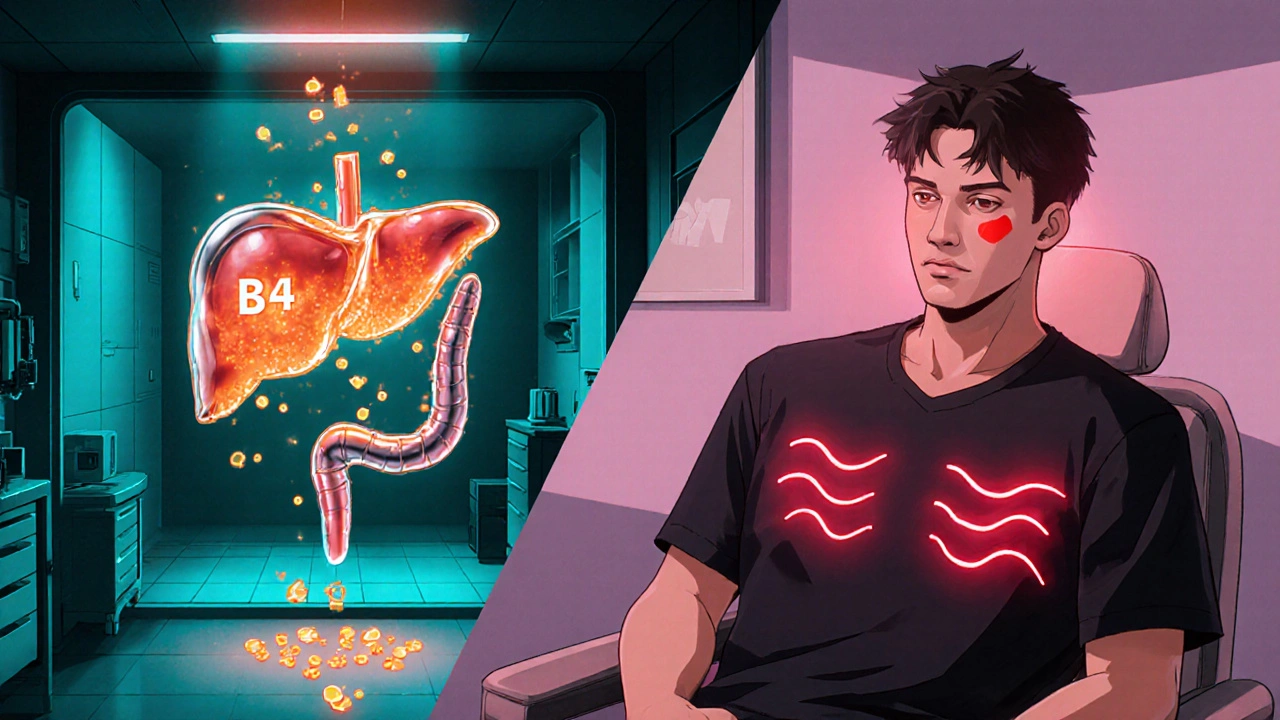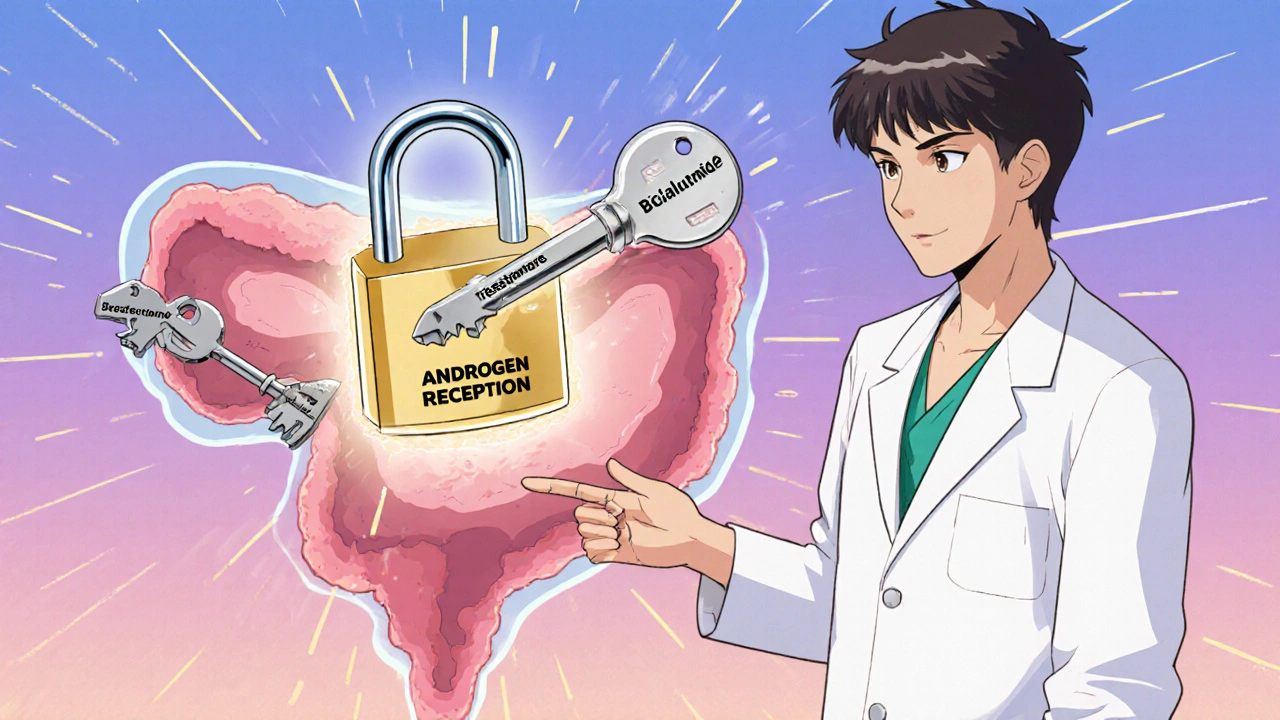Key Takeaways
- Bicalutamide is a non‑steroidal anti‑androgen used mainly for prostate cancer.
- It blocks androgen receptors, slowing tumor growth.
- Standard dose is 50 mg once daily, with adjustments for liver impairment.
- Common side effects: hot flashes, breast tenderness, nausea, and fatigue.
- Serious risks include liver toxicity and cardiovascular events; regular lab monitoring is essential.
When doctors talk about hormone‑driven prostate tumors, the name Bicalutamide is a non‑steroidal androgen receptor antagonist approved for treating advanced prostate cancer. First launched in the early 1990s, it quickly became a frontline option because it targets the same receptor that testosterone binds to, but without the steroid backbone that can cause broader hormonal swings.
Understanding how Bicalutamide works requires a quick look at the disease it fights. Prostate Cancer is a malignancy that originates in the prostate gland, a small organ producing seminal fluid. Most prostate cancers are driven by androgens-male hormones like testosterone-that stimulate cancer cells to grow. When the disease progresses to a stage where the cancer no longer responds to surgical or medical castration, it is called Castration‑Resistant Prostate Cancer, a condition that still relies on the androgen receptor pathway.
Enter Bicalutamide. As an Androgen Receptor Antagonist, it binds to the receptor and prevents natural hormones from activating it. Think of the receptor as a lock; testosterone is the key, and Bicalutamide is a dummy key that fits but can’t turn, keeping the lock jammed.
Approved Uses and Clinical Context
The primary indication for Bicalutamide is as part of combined androgen deprivation therapy (ADT) for locally advanced or metastatic prostate cancer. In practice, patients receive a gonadotropin‑releasing hormone (GnRH) agonist or antagonist to lower testosterone levels, while Bicalutamide blocks any remaining androgen activity.
Regulatory bodies such as the FDA (U.S. Food and Drug Administration) and the EMA (European Medicines Agency) have approved the drug for both monotherapy (in select cases for early‑stage disease) and combination therapy. In the United States, the typical regimen is 50 mg daily, whereas European guidelines sometimes start at 150 mg daily for higher‑risk patients.
How Bicalutamide Is Processed in the Body
After oral ingestion, Bicalutamide is absorbed fairly well, reaching peak plasma concentrations within 2-4 hours. Its metabolism is largely hepatic, driven by the enzyme Cytochrome P450 3A4 (CYP3A4). Because of this reliance on liver enzymes, patients with moderate to severe hepatic impairment usually receive a reduced dose (usually 25 mg daily) or may be advised to avoid the drug altogether.
The drug’s half‑life is long-about 6 days-thanks to extensive protein binding (>96%). This prolonged exposure explains why steady‑state levels are achieved after roughly two weeks and why missed doses can still maintain some therapeutic effect.
Dosage, Administration, and Monitoring
Standard dosing guidelines are straightforward:
- Start with 50 mg of Bicalutamide taken orally once daily, preferably at the same time each day.
- If the patient has mild liver dysfunction (Child‑Pugh A), consider a 25 mg reduction.
- For severe liver disease (Child‑Pugh B/C), the drug is generally contraindicated.
Monitoring should include:
- Baseline liver function tests (ALT, AST, bilirubin) and repeat every 4 weeks for the first three months, then quarterly.
- Serum testosterone and estradiol levels every 6 months to gauge hormonal suppression.
- Cardiovascular risk assessment-blood pressure, lipid profile-especially in patients with pre‑existing heart disease.
Doctors also track the Gleason Score, a grading system that predicts tumor aggressiveness. Changes in the Gleason pattern over time can signal the need to adjust therapy.

Common Side Effects
Most patients tolerate Bicalutamide well, but hormonal blockade inevitably causes some reactions:
- Hot flashes - occurring in up to 40 % of users.
- Breast tenderness or gynecomastia - reported in 30 % of men; can be managed with radiation or anti‑estrogens if bothersome.
- Gastrointestinal upset - nausea, mild diarrhoea, or abdominal discomfort.
- Fatigue and mild headache - usually transient.
These side effects are generally dose‑related and often improve after the first few weeks as the body adapts.
Serious Risks and When to Seek Help
While rare, several serious adverse events warrant immediate medical attention:
- Liver toxicity - sudden rise in ALT/AST > 3 × ULN, jaundice, or right‑upper‑quadrant pain.
- Severe allergic reactions - rash, swelling, or difficulty breathing.
- Cardiovascular events - unexplained chest pain, palpitations, or sudden swelling in the limbs (possible deep‑vein thrombosis).
Because Bicalutamide can elevate estrogen levels indirectly, long‑term users sometimes develop bone loss. Dual‑energy X‑ray absorptiometry (DEXA) scans every 1-2 years are recommended for men over 65 or those on prolonged therapy.
Drug Interactions to Watch
Since Bicalutamide is metabolized by CYP3A4, any strong inducer or inhibitor of this pathway can alter its plasma levels. Common culprits include:
- Inducers: rifampin, carbamazepine, St John’s wort - may lower Bicalutamide concentration, reducing efficacy.
- Inhibitors: ketoconazole, erythromycin, grapefruit juice - can raise levels, increasing toxicity risk.
Additionally, anticoagulants such as warfarin may have their effect amplified, so INR monitoring is advised when starting or stopping Bicalutamide.

Comparison with Other Anti‑Androgens
| Attribute | Bicalutamide | Flutamide | Enzalutamide |
|---|---|---|---|
| Class | Non‑steroidal AR antagonist | Non‑steroidal AR antagonist | Second‑generation AR antagonist |
| Typical Dose | 50 mg once daily | 250 mg three times daily | 160 mg once daily |
| Half‑life | ~6 days | ~5 hours | ~5.8 days |
| Key Side Effects | Gynecomastia, liver enzyme rise | Severe GI upset, hepatotoxicity | Seizure risk, fatigue |
| Approved Indications | Advanced prostate cancer (ADT combo) | Advanced prostate cancer (less common now) | Metastatic castration‑resistant prostate cancer |
Enzalutamide is newer and more potent but carries a higher seizure risk. Flutamide requires multiple daily doses and has a higher liver‑toxicity profile, which is why many clinicians now prefer Bicalutamide as the first‑line anti‑androgen.
Practical Tips for Patients and Caregivers
- Take the tablet with food to reduce stomach irritation.
- Set a daily reminder - consistency helps maintain steady drug levels.
- Report any new breast tenderness or swelling early; radiation therapy can prevent permanent enlargement.
- Keep a log of blood test results; share trends with your oncologist.
- Stay active and maintain a balanced diet - exercise can mitigate bone‑loss risk.
Frequently Asked Questions
Can Bicalutamide be used as a standalone treatment?
In early‑stage disease some clinicians prescribe Bicalutamide alone, but guidelines favor combination with GnRH therapy for most advanced cases because the dual approach offers stronger androgen suppression.
How long can a patient stay on Bicalutamide?
Patients may remain on therapy for years as long as disease control is maintained and liver function stays within safe limits. Regular imaging and PSA (prostate‑specific antigen) testing guide duration.
What should I do if my liver enzymes rise?
A mild rise (1-2 × ULN) often warrants closer monitoring. If enzymes exceed 3 × ULN or symptoms appear, the doctor typically reduces the dose or stops Bicalutamide and switches to an alternative anti‑androgen.
Is it safe to take Bicalutamide with statins?
Most statins are metabolized by CYP3A4 as well, so doctors may choose a statin with a lower CYP3A4 interaction (e.g., pravastatin) and monitor lipid levels and liver tests.
Can Bicalutamide cause infertility?
Yes, because it suppresses testosterone, which is essential for sperm production. Men desiring fertility should discuss sperm banking before starting therapy.
Next Steps for Readers
If you or a loved one has been prescribed Bicalutamide, schedule a baseline blood panel, ask your doctor about the expected timeline for PSA changes, and set up a reminder system for daily dosing. For deeper insight, consider reviewing the latest clinical trial data on second‑generation anti‑androgens, which can help you discuss potential future switches with your oncologist.


Rhea Lesandra
October 26, 2025 AT 15:22If you’re starting Bicalutamide, set up a daily routine that includes a pill with a meal to keep your stomach settled.
Consistency is key, so use a phone alarm or a pillbox to avoid missed doses.
Because the drug hangs around for about six days, a missed dose won’t disappear instantly, but sticking to the schedule helps maintain steady blood levels.
Before you begin, ask your doctor for a baseline liver panel; this will be the benchmark for spotting any early toxicity.
Repeat the liver tests every four weeks during the first three months, then switch to quarterly checks as you settle in.
If you notice any right‑upper‑quadrant pain, yellowing of the skin, or a sudden jump in ALT/AST above three times the upper limit, call your provider right away.
Bone health is another hidden issue, since lowering testosterone can accelerate bone loss over time.
A DEXA scan every one to two years is recommended, especially if you’re over 65 or have other risk factors.
Weight‑bearing exercise like walking, resistance training, or swimming can help preserve bone density while you’re on therapy.
Keep a log of your PSA numbers, imaging results, and any side‑effects you experience; this makes follow‑up visits more productive.
If you develop gynecomastia, radiation or anti‑estrogen medication can shrink the tissue and reduce discomfort.
Mild hot flashes and fatigue often fade after a few weeks as your body adjusts to the hormonal shift.
Stay hydrated, limit alcohol, and talk to your doctor before adding over‑the‑counter supplements that might strain the liver.
Common CYP3A4 inducers like St John’s wort or certain antiepileptics can lower drug levels, so disclose any herbal products you use.
Conversely, strong CYP3A4 inhibitors such as grapefruit juice or ketoconazole can raise concentrations and increase side‑effect risk.
By staying proactive with monitoring, lifestyle tweaks, and open communication with your care team, you can maximize the benefits of Bicalutamide while minimizing its drawbacks.
Tim Waghorn
October 27, 2025 AT 16:33Bicalutamide undergoes extensive hepatic metabolism via the CYP3A4 isoenzyme, making concomitant use of potent inducers or inhibitors clinically significant.
Agents such as rifampin, carbamazepine, and St John’s wort may reduce plasma concentrations, potentially compromising oncologic efficacy.
In contrast, ketoconazole, erythromycin, and grapefruit juice can elevate drug levels, increasing the probability of hepatic toxicity.
When prescribing anticoagulants like warfarin, clinicians should monitor INR more frequently due to possible pharmacodynamic potentiation.
The prescribing information advises dose adjustment or heightened laboratory surveillance under these circumstances.
Jacqui Bryant
October 28, 2025 AT 17:43Take the tablet with food to lessen stomach irritation and improve absorption.
Paul Luxford
October 29, 2025 AT 18:53Acknowledging the metabolic considerations, scheduling regular liver function panels helps catch any deviation early.
Johnae Council
October 30, 2025 AT 20:03Honestly, this anti‑androgen feels like a chemical gamble that swaps one set of problems for another, and the hype around its safety is seriously overstated.
Manoj Kumar
October 31, 2025 AT 21:13One could argue that spending decades on a drug that masquerades as a dummy key while the body sings the blues is the ultimate illustration of modern medicine’s existential comedy.
It promises tumor control yet gifts patients with gynecomastia, liver whispers, and bone whispers, a true paradox of benefit versus burden.
While researchers trumpet its pharmacokinetics, the patient lives in a world of daily alarms, lab appointments, and the occasional hot flash that feels like a tiny rebellion.
Such contradictions remind us that every therapeutic victory carries a shadow, and the only rational response is to navigate it with informed patience.
Hershel Lilly
November 1, 2025 AT 22:23Your observation captures the trade‑off well, and sharing personal strategies for managing those side effects can empower fellow patients.
Carla Smalls
November 2, 2025 AT 23:33Remember, building a routine around medication, exercise, and nutrition creates a strong foundation that often outweighs the occasional discomfort.
Monika Pardon
November 4, 2025 AT 00:43Sure, the pharma giants love to hide the real bone‑loss data.
Kasey Marshall
November 5, 2025 AT 01:53Monitor liver enzymes regularly; adjust dose if ALT/AST > 3× ULN.
Keep blood pressure in check; watch for swelling or chest pain.
Dave Sykes
November 6, 2025 AT 03:03Do not ignore persistent fatigue-report it promptly and ask your oncologist about dose modification or supportive therapy.
Erin Leach
November 7, 2025 AT 04:13I understand how overwhelming the information can feel; taking it step by step and leaning on your care team makes the journey more manageable.
Erik Redli
November 8, 2025 AT 05:23All the hype about Bicalutamide’s safety is a myth, and patients deserve to hear the raw truth about its hidden dangers.